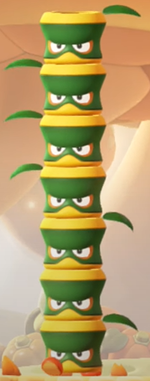Gamboo: Difference between revisions
mNo edit summary |
m (forgot the category) |
||
| Line 27: | Line 27: | ||
|meaning1=Combination of「竹」 (take, bamboo) and the affectionate suffix 「坊」 (-bō). | |meaning1=Combination of「竹」 (take, bamboo) and the affectionate suffix 「坊」 (-bō). | ||
}} | }} | ||
{{SMBW}} | |||
[[Category:Super Mario Bros. Wonder enemies]] | |||
Revision as of 10:47, November 4, 2023
This article is about a subject in an upcoming or recently released game. When the game is released, or more information about this subject is found, this article may need major rewriting.
This notice should be removed after a month has passed since the game was first released.
The title of this article is conjectural; an official name for the article's subject has not been found, so it has been given a fitting title by the editors.
If an acceptable name is found, then the article should be moved to the new title.
| Gamboo | |
|---|---|

| |
| First appearance | Super Mario Bros. Wonder (2023) |
Takebos are bamboo-like enemies of various colors often seen in stacks that were introduced in Super Mario Bros. Wonder. Green and purple variants were introduced in The Midway Trial: Hop to It, with metallic ones being first shown in Missile Meg Mayhem. Stacks of Takebos often hide in the ground and pop up when the player gets near. These enemies can be thrown when stomped; capable of defeating other enemies the same as a Shell, but functioning differently as they instead bounce off the ground a few times before losing momentum.
Metallic Takebos can interact with electricity in the level High-Voltage Gauntlet. In its electrical state, the player cannot touch them without taking damage, even if the enemy is in its stomped state.
Silver and purple Takebos turn around when facing a ledge, as its green and golden counterparts fall off of edges. Some can also be seen dancing in place during different Wonder Effects.
Gallery
- Gold Bamboo Thing.jpg
A golden Takebo
- Silver Bamboo Thing.jpg
A silver Takebo after interacting with electricity
Additional names
Internal names
| Game | File | Name | Meaning
|
|---|---|---|---|
| Super Mario Bros. Wonder | todo | Takebo | Combination of「竹」 (take, bamboo) and the affectionate suffix 「坊」 (-bō). |
